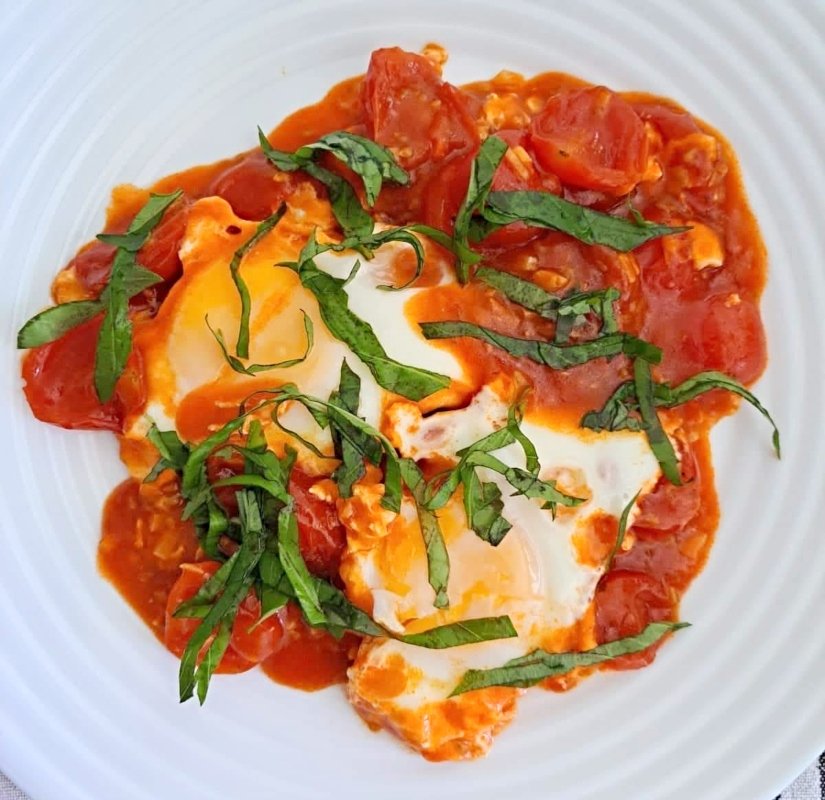Eggs in Purgatory (with Cheese or Herbs)
Eggs in Purgatory topped with fresh basil.
Shakshuka has long been one of my go-to vegetarian breakfasts (or lunches…or dinners): It’s easy, versatile, and healthy. Recently, though, spicy eggs in purgatory (basically Italian shakshuka) has been my weekend vegetarian brunch dish of choice.
What’s the difference between shakshuka and eggs in purgatory?
They’re both eggs poached in a tomato-based sauce, but shakshuka is a classic northern African/Middle Eastern dish, so the spices reflect that, with most versions containing cumin and paprika. It’s also often topped with herbs like parsley and cilantro. Eggs in purgatory is Italian and is meant to be a bit spicy, so it’s flavored with hot pepper flakes and traditionally topped with basil.
Both dishes are very versatile, with ingredients and amounts varying depending on who you talk to. When I make shakshuka, it contains onions, garlic, bell peppers, and tomatoes, and is quite chunky. But when I make eggs in purgatory, I only use garlic and tomato, and it’s much saucier.
Cheesy eggs in purgatory.
This is part of the appeal of eggs in purgatory for me: it’s very simple and very tasty. I can just throw it together in the morning when I don’t feel like chopping up a bunch of vegetables and eat it with a nice baguette.
There are a couple of variations I use when making eggs in purgatory: the first is the classic way, topped with herbs. The second is a heartier, gimme-that-melty-cheese version for days that you would usually order pizza, but you’re actually planning a healthy dinner instead, so you make up for it by putting cheese on your eggs. Anyone else have those days??
Putting cheese on top of your eggs in purgatory isn’t “traditional”, but it IS good. Obviously.
The versatility of eggs in purgatory is another reason it’s such a great dish. You can work with what you have on hand and what you’re craving. It’s the kind of thing you don’t actually need a recipe for, but I’ve posted mine here for anyone who isn’t that familiar with it or wants to know a basic method of preparing it. After you’ve made it a few times, you’ll have a good idea of what flavors and ingredients appeal to your tastes.
Recommended accompaniment: olive baguette.
Notes on the ingredients:
Tomatoes: I use a combination of fresh tomatoes and tomato sauce. Sometimes I use a larger tomato and dice it up, while sometimes I use cherry tomatoes.
Chili: Hot red pepper flakes give eggs in purgatory its signature punch, but you can use something else for heat if you’d like. I often do a combination of red pepper flakes and chili oil. You can experiment with varieties of chili you like or even use hot sauce (remember to adjust the salt, though!).
Herbs: Eggs in purgatory is great topped with basil. I also like chives.
Cheese: Optional, if you’re having one of those mornings you need cheese. For the cheesy eggs in purgatory pictured here, I used a combination of onion gouda and finely grated manchego. You could use any cheese you like that you having hanging around in your fridge. Mozzarella and parmesan would be perfect here! I put the cheese on top right after adding the eggs so it would melt while the eggs cooked.
Recipe:

Eggs in Purgatory (with Cheese or Herbs)
Ingredients
Instructions
- Heat olive oil in a skillet over medium-high heat.
- Add the garlic and fry until just beginning to turn golden, 1-2 minutes.
- Add the red pepper flakes, diced tomato, and tomato sauce (be careful of splatter). Mix together, turn the heat down to low, and cover with a lid. Simmer until the tomatoes begin to break down, 3-5 minutes.
- Add the salt and chili oil (if using). Stir into the tomato mixture.
- Crack 4 eggs one at a time into the tomato mixture (working quickly so the eggs will not cook unevenly). Because the sauce is fairly thin, you probably won't need to make wells for the eggs.
- If using cheese, sprinkle evenly over the skillet contents.
- Cover the skillet with a lid and cook over low heat until eggs are set to your preference (approximately 4 minutes for set whites and runny yolks).
- When cooked, turn off the heat and sprinkle fresh herbs over the top (if using).










Red curry eggs in purgatory is a quick, easy, and spicy vegetarian breakfast or brunch. It's simple and full of Thai flavor.